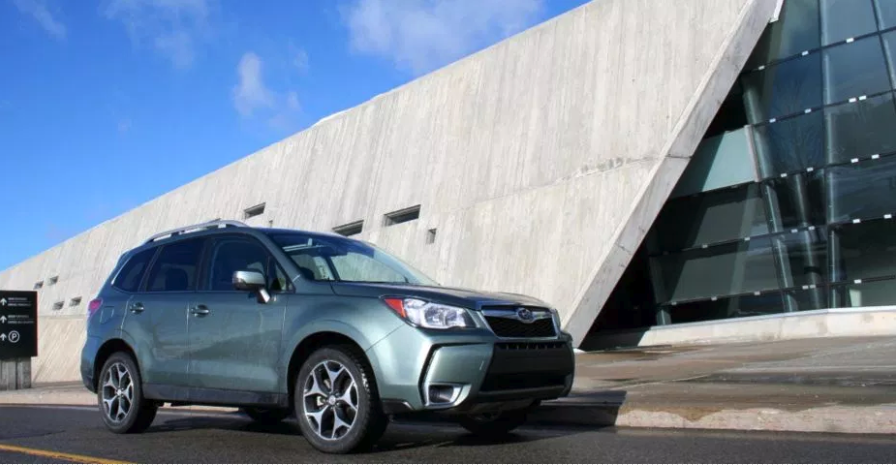Road Test: 2016 Subaru Forester 2.0XT Limited

Story and photo by John LeBlanc
One of the reasons Japan’s Subaru has become so popular with Canadians is the automaker’s split personality products. On one side of a Subaru showroom, you’ll find practical vehicles like the Impreza compacts and midsize Legacy sedans and Outback wagons. Across the room, you’ll discover Subaru’s wilder side, in the shape of the BRZ sports car and rally car-inspired WRX models. Which side of the Subaru showroom should we park the practical-yet-sporty 2016 Subaru Forester 2.0XT Limited compact crossover?
Fans of the brand have been asking for a “Forester WRX” since the Impreza-based compact crossover arrived in the late 1990s. The late 2005 Forester 2.5XT, with its turbocharged engine and manual transmission, came pretty close to making that wish come true. However, we’ve yet to see a truly sporty Forester from the wrenches at Subaru Tecnica International (or STI), the automaker’s motorsports division, with the same level of overall performance as the Impreza WRX and WRX STI models.
Subaru can’t use weak sales to argue against not building a new “Forester WRX.” In the super-hot Canadian compact crossover market, Subaru can’t sell enough Foresters. A redesign for 2014 saw a larger, more refined Forester garner a broader audience. With sales over 12,000 last year, the crossover has become the most popular Subaru in Canada, helping the Japanese automaker’s overall sales gain more than 10 percent compared to 2014, to over 46,000 new cars and trucks sold in Canada in 2015.
Competitively priced with rivals like the Ford Escape, Honda CR-V, Mazda CX-5and Toyota RAV4, base prices start with the $25,995 (not including a $1,675 freight and pre-delivery inspection fee) 2016 Forester 2.5i. All-wheel-drive and a six-speed manual gearbox come standard, along with a 170 horsepower and 174 lb.-ft. of torque delivered by the 2.5-litre flat-four gas engine.
The $33,495 Forester 2.0XT Touring is the least expensive way to get the upgraded 250-horsepower and 258 lb.-ft. turbocharged engine, based on the Subaru BRZ sports car’s naturally aspirated 2.0-litre flat-four. A mandatory continuously variable automatic is the lone transmission choice. My topline $37,995 Limited/Technology Package added such features as a large touchscreen with navigation and satellite radio, Subaru’s Starlink apps and services, and the EyeSight Driving Assist System.
Outside a Subaru showroom, you’ll find comparably equipped 2016 rivals like the 184-horsepower Mazda CX-5 GS and 240-horsepower Ford Escape Titanium run $33,275 and $34,399, respectively.
We’ll get to the Forester 2.0XT’s CVT in a bit. But the immediate reaction when you put your foot on the Subaru’s go-pedal is a positive experience. The blown-four is strong and smooth when pressed. It also makes for one quick cute-ute: zero to 100 km/h takes only 6.5 seconds — almost 2.5 seconds faster than a Forester 2.5i, and 1.0 and 1.5 seconds quicker, respectively, than the Subaru’s Ford and Mazda competition.
The Forester’s turbo-four also makes the CVT more livable. When matched to the less-powerful non-blown 2.5-litre unit, the Forester CVT can drone on like a campaigning politician. But the 2.0XT’s additional torque — and the Lineartronic CVT’s SI-DRIVE modes with its stepped, fake gears — delivers the more natural feel of a conventional autobox.
Like in the Subaru WRX we ran for 60 days, the Forester 2.0XT’s CVT comes with Subaru’s SI-Drive. Its choice of modes — Intelligent (normal CVT); Sport (which also affects throttle mapping) mimics a six-speed automatic; Sport Sharp (allows manual selection of eight ratios via shift paddles) — can greatly vary the Subaru crossover’s driving attitude.
If you want to drive your Forester 2.0XT like a sports compact, tap the Sport Sharp button. But don’t expect WRX-like handling. It may be quicker in a straight line, but Subaru’s suspension has been left in the La-Z-Boy setting; great for softening potholed roads, not so great for spirited driving. The Escape and CX-5 lean less and offer sharper turn-in while cornering hard. Where the sporty Subaru crossover still excels is when the pavement gets slippery or disappears completely.
The Forester 2.0XT offers a generous amount of ground clearance — just the thing to traverse unplowed winter urban streets. In addition to Subaru’s full-time all-wheel-drive system, the handy X-Mode button employs lower gear ratios to generate extra power at the wheels that have grip, deactivate the transmission’s lock-up clutch to better direct power to slipping wheels, and makes the traction control system extra sensitive so that it intervenes earlier during wheel slippage.
And if you find yourself navigating a slippery hill (as we did exiting a friend’s ski chalet), X-Mode deploys Hill Descent Control so you don’t need to apply brakes and risk locking them up when headed down steep slopes.
In the end, the 2016 Subaru Forester 2.0XT Limited is definitely the sportiest model in the lineup, but it does not warrant a WRX badge. Its non-WRX handling simply can’t match the WRX-like acceleration. And while the customization Lineartronic CVT is one of the better CVTs out there, some drivers will still want the command of a six-speed manual.





![[del.icio.us]](https://www.straight-six.com/wp-content/plugins/bookmarkify/delicious.png)
![[Digg]](https://www.straight-six.com/wp-content/plugins/bookmarkify/digg.png)
![[Facebook]](https://www.straight-six.com/wp-content/plugins/bookmarkify/facebook.png)
![[Google]](https://www.straight-six.com/wp-content/plugins/bookmarkify/google.png)
![[Reddit]](https://www.straight-six.com/wp-content/plugins/bookmarkify/reddit.png)
![[StumbleUpon]](https://www.straight-six.com/wp-content/plugins/bookmarkify/stumbleupon.png)
![[Twitter]](https://www.straight-six.com/wp-content/plugins/bookmarkify/twitter.png)
![[Email]](https://www.straight-six.com/wp-content/plugins/bookmarkify/email.png)